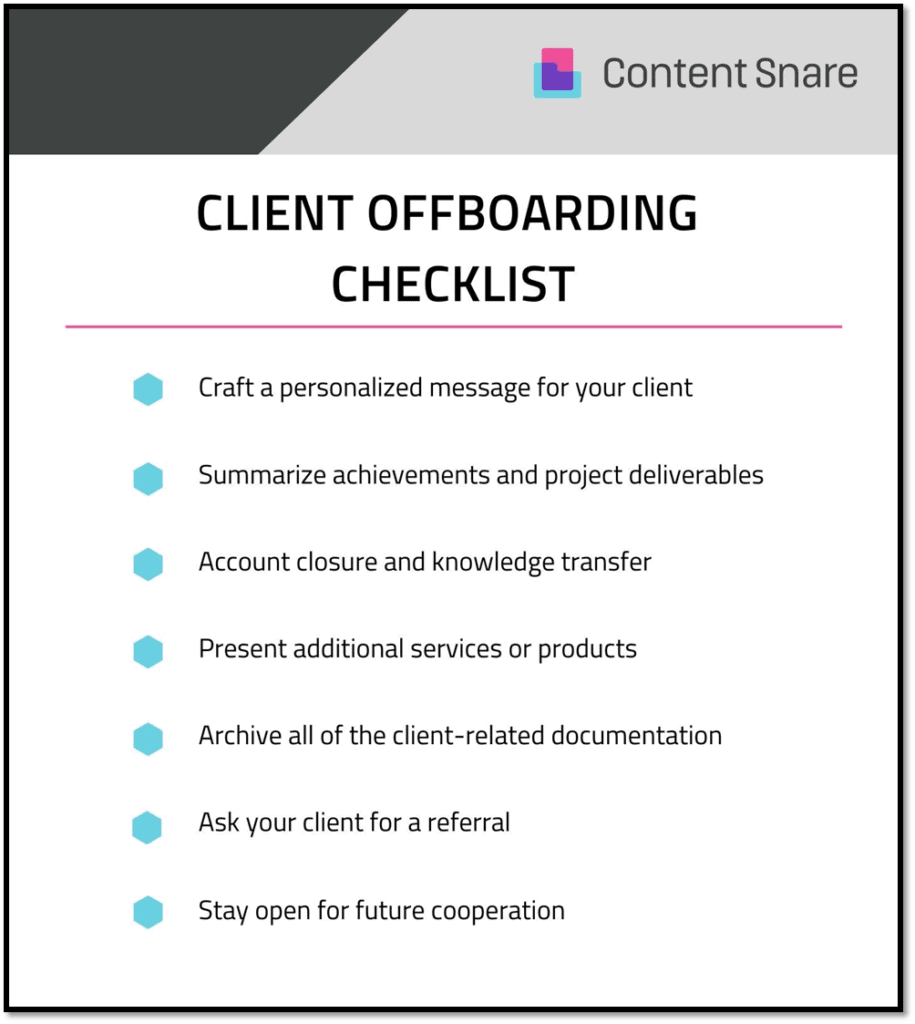Welcoming new clients is always exhilarating, but business relationships end sooner or later.
This is where client offboarding, the often overlooked counterpart to onboarding, enters the stage.
Bidding farewell to a client is not just about tying up loose ends — it's also a chance to leave a lasting impression and perhaps even set the stage for future collaborations. In this post, we’ll show you how to build a perfect client offboarding checklist.
But before we get into that, let’s answer one simple question:
What is client offboarding?

Client offboarding is the process of ending a business relationship in a systematic and organized manner.
The goal is to ensure a smooth transition and maintain a positive impression even as the business relationship comes to an end. That’s why the client offboarding process is almost as important as client onboarding.
Most businesses aren’t aware of it, but the offboarding process has a few important benefits:
- It helps you keep a positive reputation. If everything goes smoothly, you’ll end up improving overall client satisfaction, which is extremely important for your professional authority.
- Offboarding gives you the chance to build strong relationships with your client even if you go separate ways. That way, it’s much easier to ask for feedback and introduce clients to your referral program.
- A good client offboarding packet sometimes makes such a strong impression that it convinces clients to renew the working relationship. It doesn’t happen too often, but it’s definitely worth a shot.
Create a perfect client offboarding packet in 7 steps

Do you know that over 70% of businesses don’t have a formal offboarding process?
A well-designed offboarding checklist gives you the chance to stand out by improving the client experience. Here are seven ways to make a good offboarding packet.
1. Craft a personalized message for your client

You should start by showing appreciation — write a sincere message that expresses your gratitude for the opportunity to work together.
Acknowledge the client's trust in your services and mention some highlights (preferably personal) from your cooperation. A thank you note will leave a good impression on your client, which makes it a big part of the offboarding experience.
Pro tip:
You can build a strong personal connection with your client by giving them a goodbye gift. It can be a small gift like a coupon code or something you know your client will use and appreciate.
2. Summarize your achievements and project deliverables
Step two is providing a concise overview of the goals you achieved and the deliverables you provided during the project. We encourage you to highlight the key outcomes because they showcase the value added to your client’s business.
In addition, you should take care of outstanding invoices. Once you summarize project deliverables, it is time to send the final invoice to your client.
3. Account closure and knowledge transfer
The third task on your checklist is administrative but important. You must clearly outline the steps for closing clients’ accounts and/or contracts:
- Provide guidance on transferring access and credentials
- Tell them which accounts will be closed
- Explain what will remain available
You should also equip your client for their post-engagement journey. That means listing the tools and resources they'll need to continue their work independently.
Pro tip:
Service-based businesses should add support contacts for these resources, just in case something goes wrong. A proactive approach demonstrates your commitment to the ongoing success of past clients.
4. Present additional services or products
When one door closes perhaps another will open.
That’s why a client offboarding packet must include a presentation of ancillary products or services. You should seize the opportunity to showcase extra offers that your client might find valuable in the future.
But these can’t be off-the-shelf solutions.
On the contrary, we are talking about tailored recommendations based on your client’s business needs.
5. Archive all of the client-related documentation

Another important tip is to organize a comprehensive archive of all project-related documents, reports, and communications. That way, you’ll have everything prepared if your client ever comes back or asks for additional information about the project.
This step is fairly simple for companies relying on modern project management systems.
6. Ask your client for a referral
Don't hesitate to ask for a referral if your client had a positive experience. Invite them to your referral program and say you’d be grateful for any recommendations they can provide.
This can lead to new opportunities down the road.
However, you should also be ready for constructive criticism. Ask your clients for constructive feedback as it may help you improve your services in the long run.
7. Stay open for future cooperation
Last but not least, you should close out the client offboarding packet on a warm note by expressing your willingness to collaborate again in the future.
It’s best to leave the door open for any potential projects or partnerships, showing that your interest in their success extends beyond the current engagement.
The don’ts of client offboarding

This post is mainly about the things you need to do in order to successfully off-board a client, but what about the opposite? It turns out there are a few critical actions that might as well ruin your professional reputation.
Let’s see the most important don’ts of the client offboarding process:
- Don't burn bridges: Losing a client isn’t easy, but that doesn’t mean you are allowed to be disrespectful or rude. You should treat the client with the same level of respect as when you started the relationship.
- Don't withhold information: Avoid withholding important information your client might need for a smooth transition. That means providing necessary documentation, passwords, access details, and other relevant data.
- Don't ignore feedback: Disregarding the client's feedback or reasons for ending the engagement will backfire. Instead of neglecting it, you ought to use their feedback as an opportunity to improve your services.
- Don't ghost them: You can never suddenly disappear or cut off communication. Keep the lines of communication open instead in order to address any questions or concerns from their side.
Streamline your offboarding process with a checklist
Clients come and go, and there’s nothing wrong with that. However, your business relationships can get awkward if you don’t provide your soon-to-be-former clients with solid offboarding experiences.
We showed you seven ways to create a comprehensive offboarding checklist, but here’s one final tip — keep your offboarding efforts personalized and unique.
Treat each client with due attention to close the relationship on a high note. Regardless of your general offboarding strategy, a personalized approach will help you end the client relationship in a professional way.



